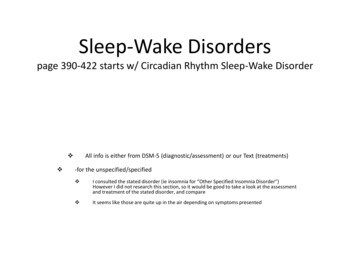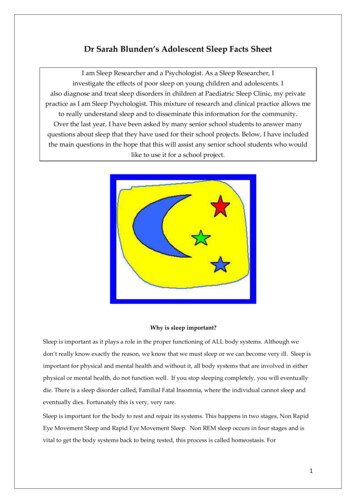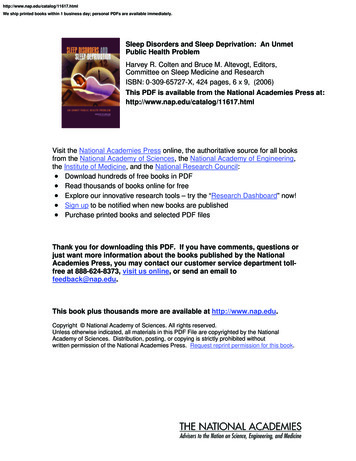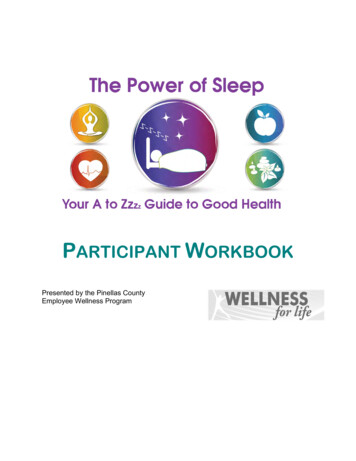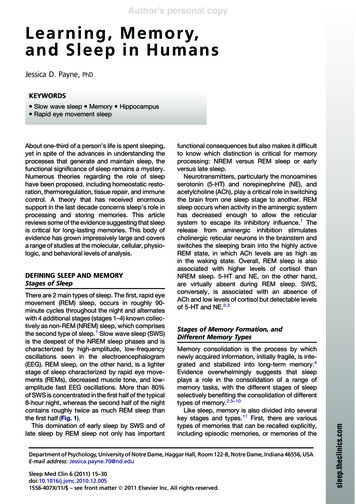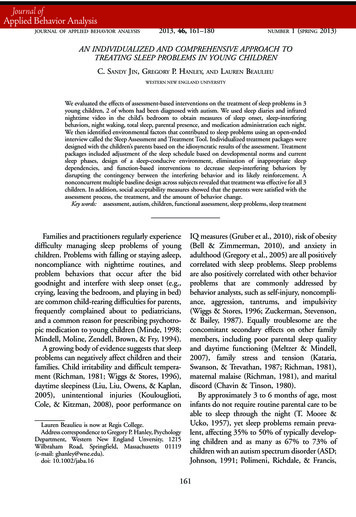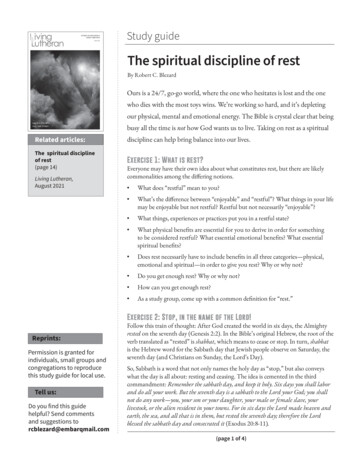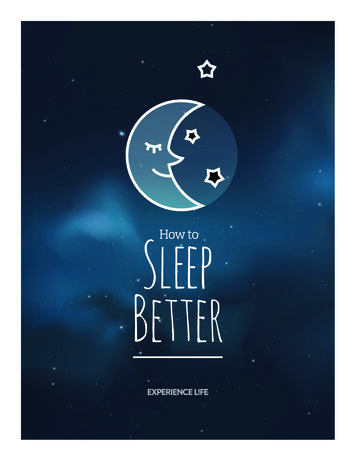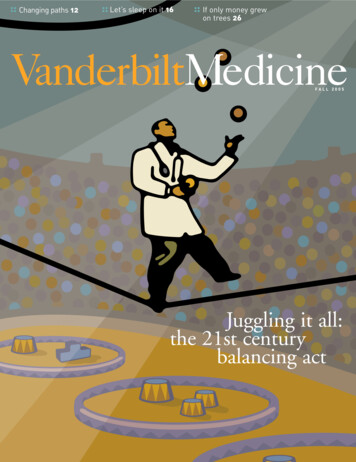
Transcription
:: Changing paths 12:: d e p a r t m e n t:: Let’s sleep on it 16:: If only money grewon trees 26VanderbiltMedicineFALL 2005Juggling it all:the 21st centurybalancing act
Get your copy of the new cookbookby the Friends ofMonroe Carell Jr. Children’s Hospital at VanderbiltVanderbiltMedicineVOLUME 22, NUMBER IIIVanderbilt Medicine is published by VanderbiltUniversity Medical Center in cooperation with theVUMC Office of News and Public Affairs.Copyright Vanderbilt UniversityEDITORNancy HumphreyDIRECTOR OF PUBLICATIONSMEDICAL CENTER NEWSAND PUBLIC AFFAIRSWayne WoodCONTRIBUTING WRITERSDoug CampbellClinton ColmenaresNancy HumphreyJerry JonesLeigh MacMillanElizabeth OlderJessica PasleyKathy WhitneyWayne WoodPearl Zink, M.D.PHOTOGRAPHY/ILLUSTRATIONNeal AspinallDean DixonDana JohnsonMarie Lancaster-DawsonAnne RaynerDESIGNDiana Duren/Corporate Design, NashvilleEntertaining with Friends at 35.00 each Case of 10 cookbooks at 350.00 Pick up (free) Shipping 6.00 per book Sales tax 9.25% - 3.24 per book or 32.40 per caseTotal COVER ILLUSTRATIONNeal AspinallEDITORIAL OFFICEOffice of News and Public AffairsCCC-3312 Medical Center NorthVanderbilt UniversityNashville, Tenn., 37232-2390VANDERBILT MEDICALALUMNI ASSOCIATIOND-8200 Medical Center NorthNashville, TN 37232-2106(615) 322-6146(800) 288-0266Fax: (615) 322-1892e-mail: medalum@vanderbilt.eduVisit us at: www.mc.vanderbilt.edu/alum-affairs
VanderbiltMedicineFALL 2005:: o n t h e c o v e rPhysicians in the 21st century willjuggle many things, among themfighting burnout, paying off medicalschool debt and balancing theirprofessional and personal lives.CHANGING PATHS:: d e p a r t m e n t s12SLEEP22DEBT26:: f e a t u r e sMaking the Rounds 2Around the Medical Center 3Changing paths 12Healthtalk 7While may physicians fight burnout, some opt for a new path.Alumni Profile 8Canby Robinson Society 29Alumni Journal 33Let’s sleep on it 16Are the new duty hours working?Alumni/Faculty News 34The distressed physician 22When the stressed physician becomes the distressed physician.If only money grew on trees 26Medical students shouldn’t have to make career choices based on theirlevel of debt.THE DISTRESSED PHYSICIAN22F A L L2 0 0 51
:: m a k i n g t h e r o u n d sBY HARRY R. JACOBSON, M.D.Vice Chancellor for Health AffairsI am a doctor. I love being a doctor.DEAN DIXONI would not trade my life for any other.Our profession remains one of themost rewarding and fulfilling, but it alsoremains perhaps the most demanding.Disturbingly, however, the rewards havediminished and the demands have blossomed. This issue of Vanderbilt Medicinelooks at the unique pressures that facepracticing physicians and the growingchallenges that confront the students atthe doorstep of our profession.As part of our orientation of newmembers for the Board of Trust, I enjoyshowing just how demanding our profession is. I use a simple chart to depict therigor and value of various professionaldisciplines. It shows the time it takes toachieve professional certification in variousprofessions, the cost of the preparation forthose careers and the lifetime earningsvalue of each.A typical business school graduatecompletes his or her MBA in two yearswith entry-level earnings that oftenexceed 100,000. For a law graduatethe course work is three years long andresults in starting salaries that match theirMBA brethren.A nursing student at Vanderbiltgraduates with an MSN in two years andbegins a career with a salary that rangesbetween 45,000 and 65,000 a year.2F A L L2 0 0 5Medical school students will completetheir coursework in four years.They will then enter an “apprenticeship,” better known as residency, a periodof intense physical, intellectual and emotional rigor. This program lasts no fewerthan three years and may last as long asseven or more. Those apprenticeshipspay between 45,000 and 60,000 ayear. At the end of that seven- to 10year training period a pediatrician mighthave a starting salary of 90,000, and asurgeon, 200,000.If the brightest students in the countrymade decisions based on pure economics,they would choose business school untilevery slot was filled. Then they wouldchoose law until every program was full.It would only be then that students wouldconsider a career in medicine, and thenonly those careers in medicine that werethe most lucrative.Fortunately for us and for all of society, the most able students in America stillchoose to be doctors. And for the samereasons we did. Because it is fulfilling, itis meaningful and it offers rewards that gowell beyond financial. VM
around themedical centerNews and happenings atVanderbilt Medical CenterMedical student-run clinicopens doorsVanderbilt Medical Schoolwelcomes Class of 2009One hundred five members of the Class of 2009, the 129th class to enter themedical school, have begun their four-year medical school odyssey at VanderbiltUniversity School of Medicine.“I know you had many choices of medical schools and spent hundreds of hoursmaking your decision, but we spent thousands of hours looking through nearly 4,400applicants for this class,” said VUSM Dean Steven Gabbe, M.D. “Forty-four folksapplied for each of your positions, and we’re delighted that this class has cometogether. We believe you are among the very best and brightest of the 16,000 students at the nation’s 125 medical schools,” he said.Caroline Kim, a 2001 Harvard University graduate, said it was the studentcentered atmosphere and friendliness of the faculty and staff combined with the waythe medical school curriculum is organized that brought her to Vanderbilt. She hadapplied to several other medical schools, including Harvard, the University ofPennsylvania and Penn State, but Vanderbilt was her first choice.After attending Harvard on an ROTC scholarship, she spent the past four yearson active duty — in Korea for a year and Europe for three. She lived in Germanyduring the medical school application process.“Vanderbilt extends a welcoming feeling to the interviewees,” she said. “Theother schools were totally about competition.”The Class of 2009 comes from 33 states, six foreign countries — Australia,Canada, Ghana, Kenya, Nigeria and Pakistan — and 60 colleges and universities.Sixteen of the students are graduates of Vanderbilt University. VM-NANCY HUMPHREYANNE RAYNERThe Shade Tree Family Clinic, runby Vanderbilt University School ofMedicine students, made its debut inOctober, providing much needed freehealth care to Nashville’s medicallyunderserved community.The clinic, operated by VUSM inpartnership with United NeighborhoodsHealth Services, is open Saturdays fromnoon to 4 p.m., and Tuesdays from 6-9p.m., and is located in East Nashville.VUSM students, under the supervision of attending physicians, provideurgent and chronic walk-in care at theclinic for the area’s uninsured patients.The clinic also provides health educationand patient referrals and acts as a“bridge” between the medically underserved community and other componentsof the region’s health care system.Public response to the new clinichas been strong, said second-yearmedical student Dana Guyer, one of theclinic’s directors.“We have been working closelywith community organizations andneighborhood residents to get theirinput and support for the clinic.Everyone we’ve worked with has beenincredibly positive, and from the feedback we’ve received it seems thatneighbors think the clinic will be greatfor the community.“The medical students are thrilledto be able to get out in the communityand interact with patients and we’re hoping that our clinic will have a sustainableimpact on this community,” Guyer said.Primary funding for the Shade TreeFamily Clinic came from a grant fromthe Newman’s Own Foundation for 35,000 over two years. The clinic alsorecently received a 25,000 grant fromthe Rasmussen Foundation. Vanderbiltis providing financial and administrativesupport for the clinic, with a goal ofShade Tree becoming a vital part of themedical safety net for uninsured andunderinsured patients in Nashville. VM-DOUG CAMPBELL::F A L L2 0 0 53
:: a r o u n d t h e m e d i c a l c e n t e rWilliam Stead, M.D., has beenselected as Vanderbilt’s first McKessonFoundation Professor of BiomedicalInformatics.Stead, associate vice chancellor forHealth Affairs and director of theInformatics Center, will continue to behonored for years to come by McKessonFoundation’s gift, 2 million disbursedover the next five years. The chair is his tohold as long as he wants, and when hevacates the position it will then be calledthe McKesson Foundation-WilliamStead Chair in Biomedical Informatics.“I cannot imagine anything thatwould be a greater honor than to havesomeone make this type of commitment to biomedical informatics and tomake it in my honor,” Stead said. I’mgrateful and touched by that.”Stead is internationally known as apioneer in biomedical informatics. Hecame to Vanderbilt in 1991 and has beenthe architect of the Medical Center’sinformatics strategy. Last year he waselected chairman of the board of regentsof the National Library of Medicine, one ofthe National Institutes of Health and theworld’s largest medical library. The NLMis the primary source of funding forbiomedical informatics research grants.Harry Jacobson, M.D., vice chancellor for Health Affairs, said the chairwill bolster Vanderbilt’s biomedicalinformatics efforts.“I can think of no better way tosupport future research and productionof biomedical informatics than with thisgenerous gift from the McKessonFoundation. And certainly there is nomore appropriate person to honor thanBill Stead, for his dedication and foresight have pioneered this field. Patientcare of the future will be more streamlined, more thorough and safer thanksto contributions from both Dr. Steadand investment from corporations suchas McKesson.” VM-CLINTON COLMENARES4F A L L2 0 0 5New databank will bea trove of anonymousDNA informationThe successful sequencing of the human genomeseveral years ago opened the door for a new era inmedicine, one with treatments “tailored” to fit an individualpatient’s genetic profile.Crossing the threshold of this doorway will require verylarge-scale research efforts to find the key links betweengenes and disease, and between genes and drug response.To help investigators uncover those links, VanderbiltUniversity Medical Center is beginning to build an anonymousdatabase of genetic and clinical information.“The establishment of this database will allow researchers tomore effectively and efficiently conduct important genetic research,which in turn will help improve care for patients, so it’s a win-winfor everyone,” said Gordon R. Bernard, M.D., assistant vice chancellor for Research.The database resource will use blood that would otherwise be discarded to obtainanonymous genetic samples. These “banked” samples will be associated with clinicaldata extracted from medical records without information that identifies those records.Investigators will be able to use the resource to look for patterns and parallelsbetween patients with similar diseases or who have taken similar medications.“We’ve known for a long time that individuals respond differently to drugs, and insome cases, we know the genetic reasons for these differences,” said Dan M. Roden,M.D., director of the John A. Oates Institute for Experimental Therapeutics and principalinvestigator of the DNA Databank effort. “When we understand the genetic variationsthat affect drug response more fully, we will be able to avoid rare, but catastrophic,side effects, and we will be able to identify patients with the greatest chance ofresponding well to a particular drug therapy.”Finding patterns and parallels among the billions of “letters” of DNA — to narrow in ongenes that influence drug response or cause disease — requires large numbers of samples.“We’re most interested in finding the genes that predict common, complex diseases,like diabetes, Alzheimer’s disease, cancer and heart disease,” said Jonathan L. Haines,Ph.D., director of the Vanderbilt Center for Human Genetics Research.VUMC hopes to build the database at the rate of 50,000 samples per year, with theultimate goal of having over 1 million samples, said Jill Pulley, M.B.A., director of theDNA Databank resource.Patient blood that would normally be discarded after testing will be used as thestarting material for DNA samples. A set of computer algorithms will permanentlyencrypt the sample identifiers. Another set of computer algorithms will remove allidentifying information — for example name, address, and Social Security number —from the medical record and link the remaining anonymous clinical information to theDNA sample.The computer programs ensure that it is not possible to determine the identity ofpatients from the DNA samples or clinical information. VM-LEIGH MACMILLANDOMINIC DOYLE, MEDICAL ART GROUPStead to hold newBioinformatics Chair
a r o u n d t h e m e d i c a l c e n t e r ::LifeFlight celebrates 20years of serviceAn international “team science”effort to accelerate progress toward a cellbased therapy for type 1 diabetes kickedoff in Nashville recently.The Beta Cell Biology Consortium(BCBC), formed in 2001, entered its second phase with an expanded roster andenhanced operations.Vanderbilt is home to both theCoordinating Center for the BCBC andone of the cornerstone scientific programprojects. Together, the two grants, fundedby the National Institute of Diabetes andDigestive and Kidney Diseases (NIDDK),will provide over 5 million in supportfor the next four years, said Mark A.Magnuson, M.D., Earl W. Sutherland Jr.Professor of Molecular Physiology &Biophysics and principal investigator ofboth efforts.“The Consortium is a very successfulexample of a ‘team science’ approach,”Magnuson said. “A lot has been accomplished because of it. Investigators arenow using the knowledge that’s beengained to devise strategies that will speedthe clinical transfer of this information.”The BCBC includes the “crème de lacrème” of investigators in the area of betacell biology, Magnuson said. Pancreaticbeta cells are the only cells in the bodythat secrete insulin. Destruction of theseprecious cells by a person’s own immunesystem gives rise to type 1 diabetes.Scientists in the BCBC have a widerange of expertise in areas including pancreas development, directed differentiationof stem cells and beta cell regeneration.The Coordinating Center for theBCBC facilitates activities of Consortiuminvestigators spread throughout theworld. “We’re privileged to be able toplay this role in this very important area,”said Magnuson, who has served as aleader in the BCBC since its founding.Magnuson built the Coordinating Centerhere with the assistance of Lisa Rouse,program manager, and Jean-PhilippeCartailler, Ph.D., science writer and Website manager.Fifty scientists and administratorsgathered at the Vanderbilt Center forBetter Health for the kickoff meeting.One goal of the meeting was to have“true information exchange” betweenparticipants and to begin the planningfor novel group projects.“I liken it to throwing fruit in ablender, turning it on, and seeing what youget,” Magnuson said. “It was a very intensemeeting, and we made great progress.”Vanderbilt’s scientific program isentering its 16th year of funding. Whenthe BCBC got its start in 2001, theVanderbilt group had the only existingprogram project grant focused on betacells, Magnuson said. For more information about the BCBC, visit its Web site:www.betacell.org. VM-LEIGH MACMILLANDANA JOHNSONConsortium’s ‘teamscience’ approach setssights on diabetesLeft to right:Mark Magnuson, M.D.,Roland Stein, M.D., andChristopher Wright, D. Phil.LifeFlight, Vanderbilt UniversityMedical Center’s air ambulance program, recently celebrated 20 years ofservice to the community.More then 300 people attended adinner this summer, which honoredJoseph C. Ross, M.D., who, along withJohn A. Morris Jr., M.D., professor ofSurgery and director of the Division ofTrauma and Surgical Critical Care,was one of the founders of theLifeFlight program.“LifeFlight had its inaugural flightmore than 20 years ago,” said Harry R.Jacobson, M.D., vice chancellor forHealth Affairs. “That first flight was aculmination of years of planning andcareful orchestration that built a solidnetwork of emergency servicesthroughout Middle Tennessee.LifeFlight is the bridge that ties ourregion’s emergency services networkto talented and uncommonly dedicatedphysicians and nurses and staff ofVanderbilt Trauma.”In the past 20 years, the air ambulance program has transported morethan 30,000 patients and grown from asingle helicopter to a fleet of five of themost advanced twin-engine helicopters,one airplane, critical care groundtransportation, neonatal care andstate-of-the-art transportation andemergency communications.LifeFlight has helicopter bases inLebanon, Tullahoma, Mt. Pleasant(Columbia) and Clarksville, Tenn.LifeFlight serves all local hospitals andis the exclusive provider of air ambulance services for critical care patienttransfers for TriStar Health Systems.Ross, associate vice chancellor forHealth Affairs, Emeritus, was namedas the first recipient of the Joseph C.Ross Community Award.Three families, each touched byLifeFlight, were also honored at thedinner. VM-JERRY JONESF A L L2 0 0 55
Vanderbilt UniversityHospital celebrates 25thanniversaryVanderbilt University Hospital,which opened in 1980, celebrated its25th anniversary in September.The forethought that went intothe design of the Vanderbilt UniversityHospital that opened 25 years ago isevident in the vastly changed VUH thatexists today, because the constantrenewal that is necessary to keep afacility up to date was built into thehospital’s design.On Sept. 12, 1980, patients were movedfrom the “old” hospital building — nowcalled Medical Center North — into thenew 65 million facility under the glareof TV lights and the smiles of employees.Members of the press were plied withgee-whiz facts such as, “In VUH thereare 9,000 light switches, 14,000 electricaloutlets, 2,000 public-address speakers,and 30,000 fluorescent lights.”On Monday, Sept. 15, 1980, theofficial dedication took place, with anofficial welcome issued by the one manwho, more than any other, had broughtthe new hospital from notion to reality:Vernon E. Wilson, M.D., the truck-driverturned-physician who, as vice chancellorover the Medical Center in the 1970s,had refused to settle for anything otherthan a new Vanderbilt Hospital, and ledthe Medical Center through some turbulent times.Over its 25 years VUH has beenrepurposed, reinvented, and renewedtime and time again.It has seen, among many changes:the growth of LifeFlight, which was firstlocated on a helipad on a hill outside theEmergency Department; the opening ofa Trauma Unit, the NeurologicalIntensive Care Unit and most recently,the Hybrid OR; two complete renovationsof the Emergency Department; and thecomplete relocation of Children’sHospital. VM-WAYNE WOOD6F A L L2 0 0 5DANA JOHNSON:: a r o u n d t h e m e d i c a l c e n t e rStudy shows frogs may aid in HIV fightA new weapon in the battle against HIV may come from an unusual source — asmall tropical frog.Investigators at Vanderbilt University Medical Center reported in the September Journalof Virology that compounds secreted by frog skin are potent blockers of HIV infection.The findings could lead to topical treatments for preventing HIV transmission, andthey reinforce the value of preserving the Earth’s biodiversity.“We need to protect these species long enough for us to understand their medicinal cabinet,”said Louise A. Rollins-Smith, Ph.D., associate professor of Microbiology & Immunology.Frogs, she explained, have specialized granular glands in the skin that produce andstore packets of peptides, small protein-like molecules. In response to skin injury oralarm, the frog secretes large amounts of these antimicrobial peptides onto the surface ofthe skin to combat pathogens like bacteria, fungi and viruses.Rollins-Smith and her laboratory neighbor Derya Unutmaz, M.D., associate professorof Microbiology & Immunology, decided it would be interesting to investigate whetherany frog peptides have activity against human viruses, specifically HIV, the focus ofUnutmaz’s group.They found several peptides that inhibited HIV infection of T cells, immune systemcells targeted by HIV. The frog peptides also blocked transmission of HIV from dendriticcells to T cells.Dendritic cells are the sentinels of the immune system, Unutmaz explained. These specialcells hang out in the mucosal surface tissues, scanning for and destroying invading pathogens.HIV somehow evades destruction when it is picked up by dendritic cells. It lurksinside the cells, waiting to invade the T cell with a Trojan Horse-like mechanism. Thefrog peptides blocked that invasion.“This was a great surprise,” Unutmaz said. “It suggests that these peptides could bevery effective since the virus now has nowhere to hide.” VM-LEIGH MACMILLAN
h e a l t h t a l k ::The newhysterectomyBY NANCY HUMPHREYHysterectomy is the mostcommon, non-pregnancy relatedsurgical procedure performedon women in the United States –each year, about 600,000 areperformed. More than one-thirdof women will have a hysterectomy by their 60th birthday.Vanderbilt UniversityMedical Center is one of ahandful of centers offering aless invasive technique forperforming hysterectomies, arelatively new surgical technique that uses laparoscopyHysterectomies are normally performedin two ways — total, removing the uterusand cervix; and supracervical, removing theuterus but leaving the cervix in place.alone to remove the uterus, butleaves the cervix intact.Although Vanderbilt hasbeen offering laparoscopicsupracervical hysterectomy(LSH) for the past three years,the number of women who takeadvantage of this procedure isgrowing, says Barry Jarnagin,M.D., associate professor ofObstetrics and Gynecology.With LSH, a small laparoscope and surgical instrumentsare inserted through tiny incisions in the navel and abdomento separate the uterus from thecervix. Another device dices theuterus and it is removedthrough one of the incisions.The procedure is less invasive than a traditional “open”hysterectomy where an incisionis made in the abdomen, andwas developed to reduce painand trauma to the pelvic area,minimize scarring and shortenrecovery time. Some women gohome the day of surgery,although most Vanderbiltpatients stay for 23 hours,Jarnagin said.Hysterectomies are normallyperformed in two ways – total,removing the uterus and cervix;and supracervical, removingthe uterus but leaving thecervix in place.The medical community’sthinking on hysterectomies hascome full circle, Jarnagin said.When they were first done,before the days of antibiotics,the cervix was left intact becauseof the risk of infection. Then itwas believed that removing thecervix was a good idea, becauseremoving it might help preventcervical cancer. But now, withPap smears and other means ofmonitoring for cervical cancer,it’s believed that removing thecervix may diminish sexualfunction in some women, andthat leaving it preserves thepelvic support of the vagina.“We know that 60 percentof women who undergo a totalabdominal hysterectomy by theage of 60 will have significantpelvic support problems. It ishoped that leaving the cervixwould reduce that risk,”Jarnagin said.There are practicalreasons for recommendingLSH to women who meet thecriteria – less pain and a morespeedy recovery.“You turn a procedurethat has a significant amount ofpost-op pain into a procedurethat has relatively little painand reduces the risk of surgery,the risk of bleeding, infectionand injury,” Jarnagin said.“The bladder sits right on topof the cervix so there’s lessmoving around of the bladder.”And about 1 percent to 4 percentof women have some injury tothe ureter during a total hysterectomy, he said, so there isless risk of a ureteral injury.A hospital stay for a totalabdominal hysterectomy is twoto four days, and women havesignificant discomfort and painfor several days, then limitedactivity for six weeks. WithLSH, patients go home within23 hours, some the same day,have minor post operative painfor one to five days, then canresume normal, non-strenuousactivity within one to twoweeks. Many women say theydon’t even have to take a painpill, Jarnagin said. VMF A L L2 0 0 57
:: a l u m n i p r o f i l e8F A L L2 0 0 5
a l u m n i p r o f i l e ::3.Maybe If I HurryTACKLING COLLEGE, MEDICAL SCHOOL AND TRAININGduring the Great Depression wasn’t aneasy chore for anyone, especially a young woman from a tiny Wisconsin town. But PearlZink, M.D., a 1937 graduate of Vanderbilt University School of Medicine, isn’t just anywoman. Zink, Vanderbilt’s first woman house officer from 1937-1939, had a 66-year careerin medicine, becoming a pioneer in the diagnosis and treatment of allergic diseases, in the careof patients in long-term care facilities and in bringing hospice to the terminally ill. She choseallergies because every fall, living on a farm, she battled them herself. Retired since 2003,Zink isn’t one to just sit around. At age 90, she decided to write her recollections of being awoman pioneer in the field of medicine. With Zink’s permission, excerpts from her memoirare excerpted in this issue of Vanderbilt Medicine.CHAPTER 1I’m ninety years old. NINETY YEARS OLD. Who would have believed that a little girlborn on May 24, 1913, would live to be ninety years old? The year 2000 was light years away.Why to reach that she’d have to be 87. Well, here it is 2003, and here I am and I’m ninety .I’ve outlived most of my classmates. I’ve outlived all of my close relatives except twonephews. My grandparents, my parents, two husbands, my three sisters, aunts, uncles andthe only three first cousins I’ve ever had. So many friends, so many colleagues. So manypatients, so many whose lives brushed mine .I’ve outlived them all.The day of my birthday party I went early to the beauty shop. The gray-haired lady inthe chair next to me said, “Well, Dr. Zink, I’ve finally caught you. You usually come laterand I’ve been missing you. I came to you when I was nine years old. I was wearing sandalsand my sister had painted my toenails for the first time. I was so proud of them and youtold me how pretty they were. I had eczema or something.” She added, “I’m sixty-five now.”What a lovely birthday present. Fifty-six years later she hardly remembered why she was inmy office, but she recalled that I had admired her toenails.CHAPTER 4Random CollectionsMy little sister in the swing on the lilac tree waiting for me to come home from school The russet apple tree at the school boundary that provided sustenance for the trek home Kind Mrs. Gephardt whose warm kitchen and ginger cookies gave us the energy for thefinal frigid dash home. My lifelong friend, Irma, who skipped the fifth grade with me.The books in the school library I read them all at least once.My mother’s embroidered pillow that won a blue ribbon at the state fair.The snow banks whose crusted tops would bear a child’s weight. Cold fingers andfeet Chilblains, heavy quilts, icy bedrooms.The long evenings, especially in winter, my parents and my sisters around the kitchentable under the light of a kerosene lamp, my mother crocheting or embroidering, homework. We were all THERE. I was secure. I was 13, eager to go to high school.f r o m Pe a rl L . Zi n k , M . D .F A L L2 0 0 59
:: a l u m n i p r o f i l eESKIND BIOMEDICAL LIBRARY HISTORICAL COLLECTIONESKIND BIOMEDICAL LIBRARY HISTORICAL COLLECTIONESKIND BIOMEDICAL LIBRARY HISTORICAL COLLECTIONCHAPTER 12Pictured above,from left to right:Pearl Zink's medicalschool class composite;Vanderbilt Hospital HouseStaff (Zink is third fromleft, front row); Hugh J.Morgan, M.D., center,with Chester M. Jones,M.D., left, and TinsleyHarrison, M.D.;and Pearl L. Zink, M.D.“Why did you want to be adoctor? A woman ‘n all? Wayback when?” Why indeed.I have pondered thatquestion many times.10F A L L2 0 0 5The most frequently asked Question:Why did you want to be a doctor? Awoman ‘n all? Way back when?” Whyindeed. I have pondered that questionmany times. I don’t know. There wasonly one doctor in my family, a greatuncle I never knew. Perhaps I had anepiphany, an awakening, a calling.Somewhere along the line, I had a dreamand from then on had tunnel vision. Ididn’t have the foggiest notion of whatcollege and medical school would entail,where I would get the money, or howarduous and well nigh impossible itwould be. So I plunged in. One class,after the other, one more job, one morecourse, one more semester, one moreyear. A scholarship, a loan, more jobs,help from my father, unexpected windfall.The day after graduation all the years oftoil and privation coalesced into one golden moment when Dr. (Hugh) Morganpassed me in the hall, smiled, and said,“Good morning, DOCTOR ZINK.”CHAPTER 26It was September 1933. It was myfirst day of Medical school. I was registered at both the University of Kentuckyand Vanderbilt Medical School. Ahead ofits time, Vanderbilt required an artsdegree. I had completed all the requiredsubjects, heavy on science, and lackedonly enough academic hours for a degree.Through a reciprocal agreement, I’dreceive my degree in August of 1934,after a creditable completion of my firstyear at Vanderbilt. I was 20 years old.My mother’s small legacy, with stringent economy, had seen me through threeyears in Kentucky. There was possiblyenough, with a job, to see me through myfirst year in medical school. I had found asmall room with board close to the university. With my classmates, I waited in alarge lecture room. We were 47 callowyouths and three wary young women. Welooked each other over with frank curiosity,taking stock of the 49 other individualswith whom we were going to spend thenext four years.The dean of the medical school, Dr.Waller Leathers, greeted us. He said thathe knew each of us had our own reason
Vanderbilt Medicine Changing paths12 If only money grew on trees 26:: ::::Let's sleep on it 16 Juggling it all: the 21st century balancing act. Vanderbilt Medicine VOLUME 22, NUMBER III Vanderbilt Medicine is published by Vanderbilt University Medical Center in cooperation with the
